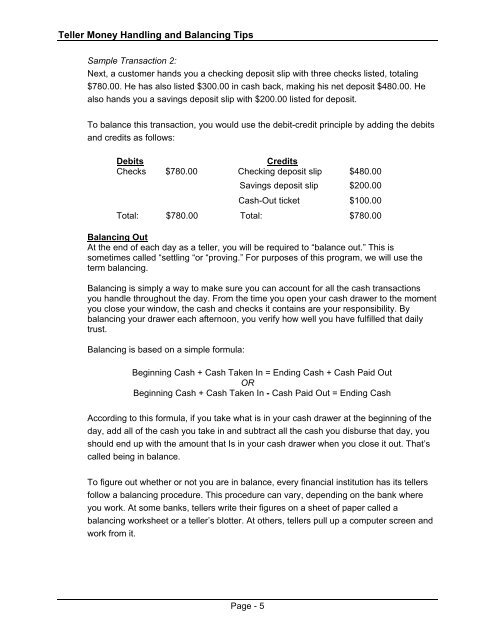Teller Skills Customer Service Fundamentals
Teller Skills Customer Service Fundamentals
Teller Skills Customer Service Fundamentals
Create successful ePaper yourself
Turn your PDF publications into a flip-book with our unique Google optimized e-Paper software.
<strong>Teller</strong> Money Handling and Balancing Tips<br />
Sample Transaction 2:<br />
Next, a customer hands you a checking deposit slip with three checks listed, totaling<br />
$780.00. He has also listed $300.00 in cash back, making his net deposit $480.00. He<br />
also hands you a savings deposit slip with $200.00 listed for deposit.<br />
To balance this transaction, you would use the debit-credit principle by adding the debits<br />
and credits as follows:<br />
Debits Credits<br />
Checks $780.00 Checking deposit slip $480.00<br />
Savings deposit slip $200.00<br />
Cash-Out ticket $100.00<br />
Total: $780.00 Total: $780.00<br />
Balancing Out<br />
At the end of each day as a teller, you will be required to “balance out.” This is<br />
sometimes called “settling “or “proving.” For purposes of this program, we will use the<br />
term balancing.<br />
Balancing is simply a way to make sure you can account for all the cash transactions<br />
you handle throughout the day. From the time you open your cash drawer to the moment<br />
you close your window, the cash and checks it contains are your responsibility. By<br />
balancing your drawer each afternoon, you verify how well you have fulfilled that daily<br />
trust.<br />
Balancing is based on a simple formula:<br />
Beginning Cash + Cash Taken In = Ending Cash + Cash Paid Out<br />
OR<br />
Beginning Cash + Cash Taken In - Cash Paid Out = Ending Cash<br />
According to this formula, if you take what is in your cash drawer at the beginning of the<br />
day, add all of the cash you take in and subtract all the cash you disburse that day, you<br />
should end up with the amount that Is in your cash drawer when you close it out. That’s<br />
called being in balance.<br />
To figure out whether or not you are in balance, every financial institution has its tellers<br />
follow a balancing procedure. This procedure can vary, depending on the bank where<br />
you work. At some banks, tellers write their figures on a sheet of paper called a<br />
balancing worksheet or a teller’s blotter. At others, tellers pull up a computer screen and<br />
work from it.<br />
Page - 5


